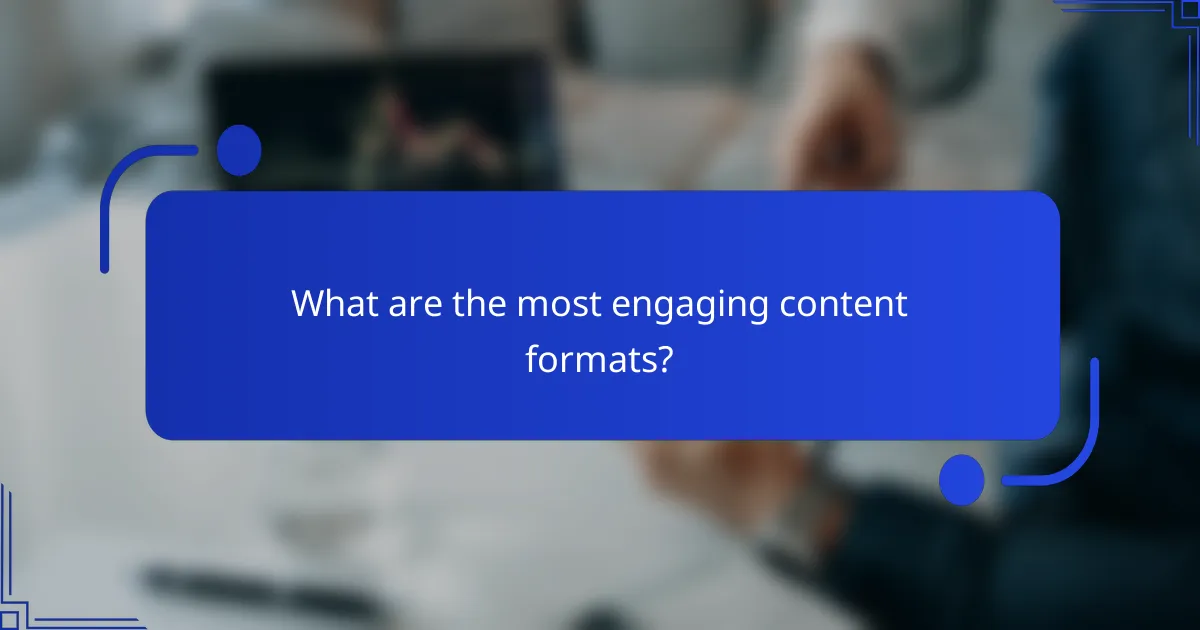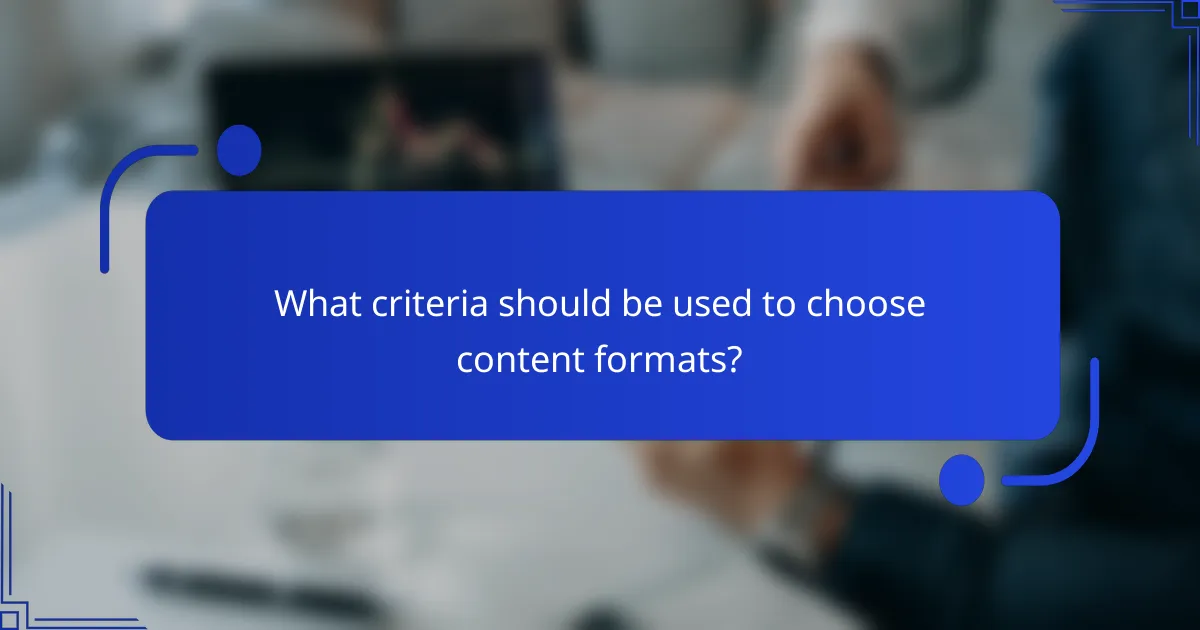Content formats play a crucial role in meeting the diverse needs of audiences by enhancing engagement and ensuring accessibility. By selecting the appropriate format, creators can effectively convey their messages, fostering interaction and satisfaction among users. Additionally, prioritizing accessibility allows all individuals, including those with disabilities, to engage with content, thereby broadening its reach and impact.

How do content formats meet audience needs?
Content formats are designed to cater to diverse audience needs by enhancing engagement, comprehension, and accessibility. By choosing the right format, creators can effectively communicate their message and ensure it resonates with their target audience.
Visual formats enhance understanding
Visual formats, such as infographics, videos, and images, significantly improve comprehension by presenting information in a digestible manner. They leverage our brain’s ability to process visuals faster than text, making complex ideas easier to grasp.
For instance, a well-designed infographic can summarize key data points in a way that is more engaging than a lengthy report. When using visual content, ensure that it is high-quality and relevant to the topic to maximize its impact.
Text formats provide in-depth information
Text formats, including articles, reports, and e-books, allow for detailed exploration of topics, making them ideal for audiences seeking comprehensive information. These formats can delve into nuances and provide context that visuals alone may not convey.
When creating text-based content, consider using headings, bullet points, and summaries to enhance readability. Aim for clarity and conciseness to keep readers engaged, and avoid jargon unless it is necessary for your audience.
Audio formats offer convenience
Audio formats, such as podcasts and audiobooks, provide a convenient way for audiences to consume content while multitasking. This flexibility allows listeners to engage with material during commutes, workouts, or household chores.
To effectively use audio formats, focus on clear narration and engaging storytelling. Keep episodes concise, ideally between 20 to 40 minutes, to maintain listener interest and encourage regular consumption.

What are the most engaging content formats?
Engaging content formats are those that capture attention and encourage interaction, leading to higher user satisfaction and retention. Common formats include videos, infographics, and interactive content, each serving unique purposes and audience needs.
Videos drive higher engagement rates
Videos often result in significantly higher engagement rates compared to static content. They can convey information quickly and effectively, appealing to both auditory and visual learners. For instance, short videos under two minutes tend to hold viewers’ attention better than longer formats.
When creating video content, consider using storytelling techniques to make the material relatable. Incorporating subtitles can also enhance accessibility, ensuring that viewers can follow along even without sound.
Infographics simplify complex data
Infographics are powerful tools for presenting complex information in a visually appealing and easily digestible format. By combining graphics with concise text, they help audiences grasp key points quickly. For example, a well-designed infographic can summarize research findings or statistics in a way that is more engaging than a traditional report.
To maximize effectiveness, ensure that your infographics are clear and not overloaded with information. Aim for a balance between visuals and text, using bullet points or icons to highlight essential data.
Interactive content boosts participation
Interactive content, such as quizzes, polls, and games, significantly increases user participation and engagement. This format encourages users to actively contribute rather than passively consume information, fostering a deeper connection with the content. For example, a quiz related to a topic can enhance learning while keeping users entertained.
When implementing interactive elements, ensure they are easy to use and relevant to your audience’s interests. Avoid overly complicated designs that may frustrate users, and consider providing instant feedback to enhance the experience.

How does accessibility impact content formats?
Accessibility significantly influences content formats by ensuring that all users, including those with disabilities, can engage with digital materials. This involves adapting formats to meet diverse needs, enhancing usability, and complying with standards like the Web Content Accessibility Guidelines (WCAG).
Alt text improves image accessibility
Alt text is a crucial element for making images accessible to users with visual impairments. It provides a textual description of images, allowing screen readers to convey the content and context of visuals to users who cannot see them.
When creating alt text, aim for concise yet descriptive language that captures the essence of the image. For example, instead of “dog,” use “a golden retriever playing fetch in a park.” This approach enhances understanding and engagement for all users.
Transcripts enhance audio/video usability
Transcripts serve as written records of audio and video content, making it accessible to individuals who are deaf or hard of hearing. They allow users to read along or review content at their own pace, improving comprehension and retention.
To maximize the effectiveness of transcripts, ensure they are synchronized with the audio or video timeline. This way, users can easily follow along and locate specific sections. Providing transcripts is not only a best practice but also aligns with accessibility regulations in many regions.
Responsive design ensures mobile access
Responsive design is essential for ensuring that content is accessible across various devices, particularly mobile phones and tablets. It allows web pages to adapt to different screen sizes, enhancing the user experience for those accessing content on smaller screens.
When implementing responsive design, prioritize readability and navigation. Use flexible layouts, scalable images, and touch-friendly elements to create a seamless experience. This approach not only meets accessibility standards but also caters to the growing number of mobile users globally.

What criteria should be used to choose content formats?
Choosing content formats requires understanding your audience’s preferences, aligning with your content goals, and ensuring compatibility with the platforms you intend to use. These criteria help create engaging and accessible content that resonates with users.
Target audience preferences
Understanding target audience preferences is crucial for selecting the right content formats. Conduct surveys or analyze existing data to determine what types of content (videos, articles, infographics) your audience engages with most. For instance, younger demographics may prefer video content, while professionals might favor detailed articles or reports.
Consider the accessibility needs of your audience as well. Formats that allow for easy navigation and comprehension, such as bullet points or short paragraphs, can enhance user experience for those with varying levels of literacy or cognitive abilities.
Content goals and objectives
Your content goals should guide the choice of formats. If the aim is to inform, detailed articles or whitepapers may be suitable. For brand awareness, engaging visuals or social media posts could be more effective. Clearly define your objectives to ensure the selected format aligns with your desired outcomes.
Additionally, think about the depth of information needed. Complex topics may benefit from a combination of formats, such as a video summarizing a report followed by a downloadable PDF for in-depth reading.
Platform compatibility
Each platform has its own strengths and limitations, which can influence your choice of content formats. For example, Instagram is ideal for visually-driven content, while LinkedIn is better suited for professional articles and industry insights. Ensure that your chosen format is optimized for the platform’s specifications.
Also, consider mobile compatibility. Many users access content on mobile devices, so formats that are responsive and easy to navigate on smaller screens are essential. Test your content across various devices to ensure a seamless experience for all users.

How do different industries utilize content formats?
Different industries leverage various content formats to meet their specific audience needs, enhance engagement levels, and ensure accessibility. By tailoring content to the preferences and requirements of their target demographics, organizations can effectively communicate and achieve their objectives.
Healthcare uses videos for patient education
Healthcare providers frequently use videos to educate patients about medical procedures, treatment options, and wellness tips. These videos can simplify complex information, making it easier for patients to understand their health conditions and care plans.
For instance, a short animated video explaining a surgical procedure can significantly reduce patient anxiety and improve comprehension. When creating educational videos, it’s crucial to ensure they are clear, concise, and accessible, adhering to regulations like HIPAA in the U.S. to protect patient privacy.
Education employs interactive quizzes
In the education sector, interactive quizzes are a popular content format that enhances student engagement and retention. These quizzes allow learners to assess their understanding in real-time and receive immediate feedback, which can reinforce learning outcomes.
For example, platforms like Kahoot! and Quizlet enable educators to create fun, interactive quizzes that can be used in classrooms or online. When designing quizzes, consider varying difficulty levels to cater to different learning paces and ensure accessibility for all students, including those with disabilities.
Marketing relies on social media posts
Marketing teams utilize social media posts to engage with audiences, promote products, and build brand awareness. These posts can take various forms, including images, videos, and text, tailored to the platform and target audience.
For effective social media marketing, brands should focus on creating visually appealing content that resonates with their audience’s interests. Regularly analyzing engagement metrics can help refine strategies and improve reach. Additionally, staying updated on platform algorithms and trends is essential for maximizing visibility and interaction.

What are emerging trends in content formats?
Emerging trends in content formats focus on enhancing user engagement and accessibility through innovative technologies. These formats, such as augmented reality and short-form video, cater to evolving audience preferences and provide immersive experiences that capture attention effectively.
Augmented reality for immersive experiences
Augmented reality (AR) creates interactive experiences by overlaying digital content onto the real world. This technology allows users to engage with products or information in a more dynamic way, enhancing understanding and retention. For instance, AR applications in retail enable customers to visualize how furniture would look in their homes before making a purchase.
When implementing AR, consider the user interface and accessibility. Ensure that the experience is intuitive and does not require extensive technical knowledge. Additionally, keep in mind that AR content should be optimized for various devices, as users may access it through smartphones or tablets.
Short-form video popularity
Short-form video has surged in popularity, driven by platforms like TikTok and Instagram Reels. These bite-sized clips cater to audiences with limited attention spans, making them ideal for quick consumption and sharing. Brands can leverage short-form video to convey messages succinctly and creatively, often resulting in higher engagement rates.
To effectively use short-form video, focus on storytelling and authenticity. Aim for content that resonates with your target audience and encourages interaction. Keep videos under 60 seconds to maintain viewer interest, and consider incorporating trending music or challenges to enhance visibility and relatability.
